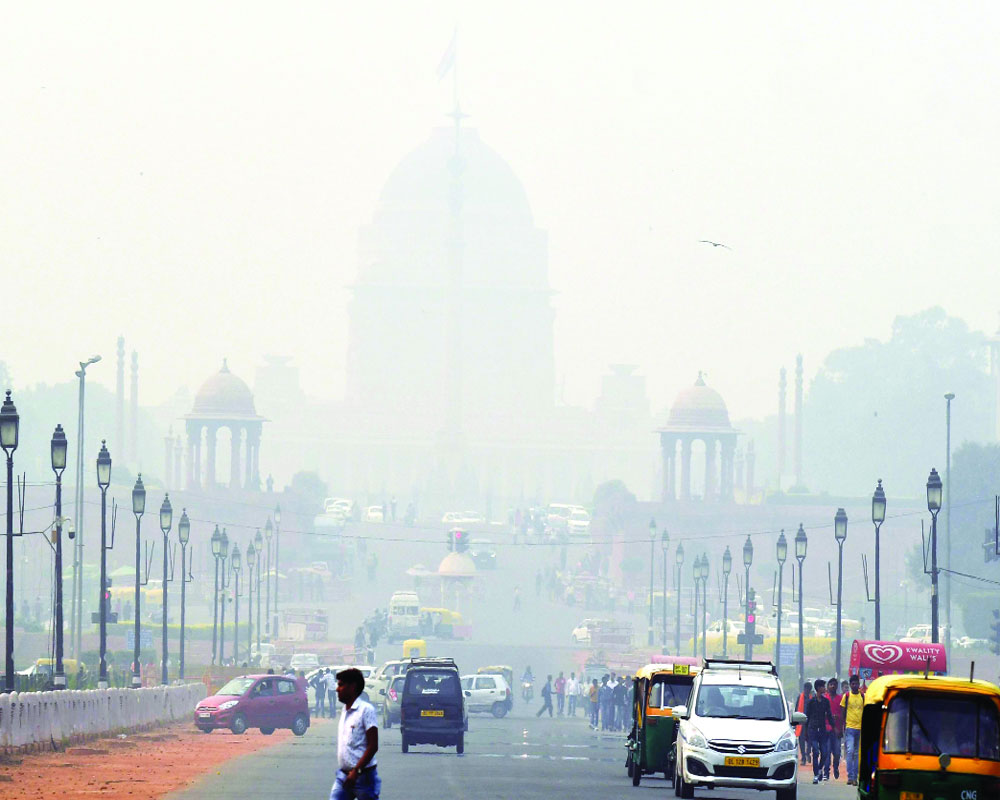Pollution twice last year's but SPM level did not spike
Skyrocketing values of harmful pollutants in Delhi’s air entered severe plus levels post Diwali on Thursday as the Average Air Quality Index (AAQI) was recorded 642 microgram per cubic meter.
According to the Centre-run pollution monitoring agency System for Air Quality and Weather and Forecasting and Research (SAFAR), the AQI (post Diwali) has been recorded “double” than previous year. It means, in 2017, the AQI was recorded at 367, in 2016, it was 425, however, this year it was over 1.7 times that of 2017. Notably, as per the SAFAR’s observations, the relative contribution of Suspended Particulate Matter (SPM) has not increased.
Citing meteorological conditions, the SAFAR in its official statement said, “At 1 am of November 8, smoke layer became thick and started to trap pollutants near the surface rapidly. The air quality entered in severe category at 2 am early morning on November 8 and will continue to remain in severe zone until late evening of the day, however, air quality is recovering from afternoon and likely to touch very poor range by night (November 8) provided no firecracker emissions are added anymore.”
The SAFAR’s statement said, “However, even if partial emissions are added pollution is likely to shoot up as stagnation condition will be triggered. Surface winds are playing a major role. The contribution of stubble fire appears to be marginal today. The contribution of PM2.5 in PM10 has increased from 50 (normal) to 70 per cent on Wednesday night indicating increased share of locally generated pyrotechnic emission.”
Importantly, on the AQI, PM 2.5 level was recorded more than eight times the permissible limit at 492 µgm-3 and PM 10 level was recorded six times the permissible limit at 618 µgm-3.
It may be noted that in 2017, official data showed the PM 10 level reached 595 µgm-3 and PM2.5 was 407 µgm-3. India’s official permissible PM2.5 limit is 60 µgm-3 while PM10 level is 100 µgm-3. It is important to mention here that as per the SAFAR’s graph on biomass burning — a contributor in terms of air pollution, the percentage is declining. The percentage of biomass burning contributing as pollutant in Delhi’s air will remain just eight per cent on November 12, the graph marked.
Meanwhile, as per the data analysis of the Delhi Government, values of Carbon Monoxide (CO), Carbon Dioxide and Sulphur Oxide also recorded higher than prescribed standards post Diwali.
Considering the database of the Delhi Government, values of CO were recorded between 0.8 mg/m3 to 4.0 mg/m3, however, in 2017, the value of same pollutant was fluctuating between 3.0 mg/m3 to 3.7.
Further, the Oxides of Nitrogen (NO2) were recorded from 29 µg/m3 to 83 whereas last year, it was 43 µg/m3 to 173.0. Another very harmful pollutant: Sulphur Dioxide (SO2) was recorded 15 µg/m3 to 81 (2018), however, in 2017 the values were 20 µg/m3 to 89 (2017). Remarkably, on National Ambient Air Quality Index (NAAQI), other popular cities — Mumbai, Ahmedabad and Pune were also densely polluted and post Diwali were tagged under the status of very poor.
The Supreme Court had allowed people to burst firecrackers from 8 pm to 10 pm only on Diwali and other festivals.
The top court also allowed manufacture and sale of just green crackers which have low emission of light, sound and harmful chemicals.
The areas where the violations were recorded included Mayur Vihar Extension, Lajpat Nagar, Lutyens’ Delhi, IP extension, Dwarka and Noida Sector 78. The assessment of Ambient Air Quality as per Central Pollution Control Board (CPCB) protocol was undertaken at 26 locations — RK Puram, Mandir Marg, Punjabi Bagh, Civil Lines, IGI Airport, Anand Vihar, Jwaharlal Nehru Stadium, Major Dhyanchand National Stadium, Dr Karni Singh shooting range, PGDAV College (Sriniwaspuri), DITE Okhla, Mother Dairy (Patparganj), ITI Vivek Vihar, ITI Jahangirpuri, DITE Wazirpur, Satyawati College (Ashok Vihar), Shaheed Sukhdev Business College (Rohini), Narela, Sonia Vihar, Shri Aurobindo Marg, Najafgarh, Pusa, Dwarka, Mundka, Bawana, and Alipur.
According to the Delhi Government average air quality data, Jahangirpuri, Ashok Vihar, Nehru Nagar, Wazirpur, Anand Vihar, Punjabi Bagh and RK Puram are the areas where values of SPM ranged between exceeded 1000 µg/m3.
Other areas such as — Sonia Vihar, Patparganj, Vivek Vihar, Major Dhyanchand National Stadium, Jwaharlal Nehru Stadium, Dwarka, Mundka, Rohini, Okhla, Bawana and IGI Airport where value generally is less than 1000 µg/m3, however, Najafgarh, Alipur, Narela, Dr Karni Singh shooting range, Shri Aurobindo Marg, Pusa, Civil Lines and Mandir Marg are stations where values are found less than 500 µg/m3.
Agra, Bhagpat , Ghaziabad, Bulandshehar, Faridabad, Gurugram, Greater Noida, Hapur, Kolkata, Lucknow, Noida, Patna, Sigrauli, Rohtak and Ujjain were the areas where AQI recorded “abnormally high, concentrations were recorded above 380 microgram per cubic.


























